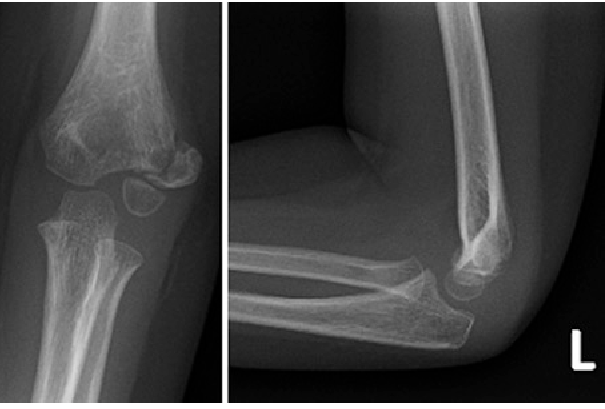
Ollie is an eight-year-old boy who is brought in by his father with left elbow pain after falling off his scooter, landing on his outstretched left hand.
He is now guarding the elbow and is reluctant to allow examination because of the pain.
Ollie is generally well, with no past history of note.
The elbow appears swollen, but there is no apparent deformity and no evidence of neurovascular compromise.
Ollie is referred for X-rays of the left elbow (pictured).
What is the most likely diagnosis?
Correct!
The anteroposterior oblique X-ray shows a small fracture — evident as a small sliver of bone at the lateral edge of the humerus (red circle) with associated significant soft tissue swelling (green arrow).
Lateral condyle fractures are the second most common paediatric elbow fracture after supracondylar fractures, accounting for up to 15% of such injuries in children.
In contrast with supracondylar fractures, neurovascular compromise is rarely seen in association with lateral condyle fractures.
This — plus the, at times, subtle X-ray findings with lateral condyle fractures — means that the diagnosis is more likely to be missed than supracondylar fractures. Consequences of missed injury include malunion, growth arrest and delayed ulnar nerve palsy.
The mechanism of injury is typically a fall on outstretched hand, with the resulting lateral force to the forearm putting varus stress on the elbow joint.
This causes the soft tissue attachments — such as the extensor muscles and lateral collateral ligaments — to avulse the lateral condyle.
This fracture may also occur with a fall onto the palm with a flexed elbow, whereupon the radial head is driven directly into the lateral condyle.
Most lateral condylar fractures are displaced less than 2mm and can be managed conservatively with a long arm cast with the elbow at 90 degrees and the forearm in pronation. Close orthopaedic follow-up is warranted as up to 15% of such injuries displace over time.
Fractures that are displaced more than 2mm, open fractures or those associated with neurovascular compromise warrant surgical repair, with closed reduction and percutaneous pinning or open reduction and internal fixation.
In this case, given there is minimal fracture displacement, Ollie is managed with a long arm cast for 4-6 weeks, at which point his X-ray shows the fracture has healed.
